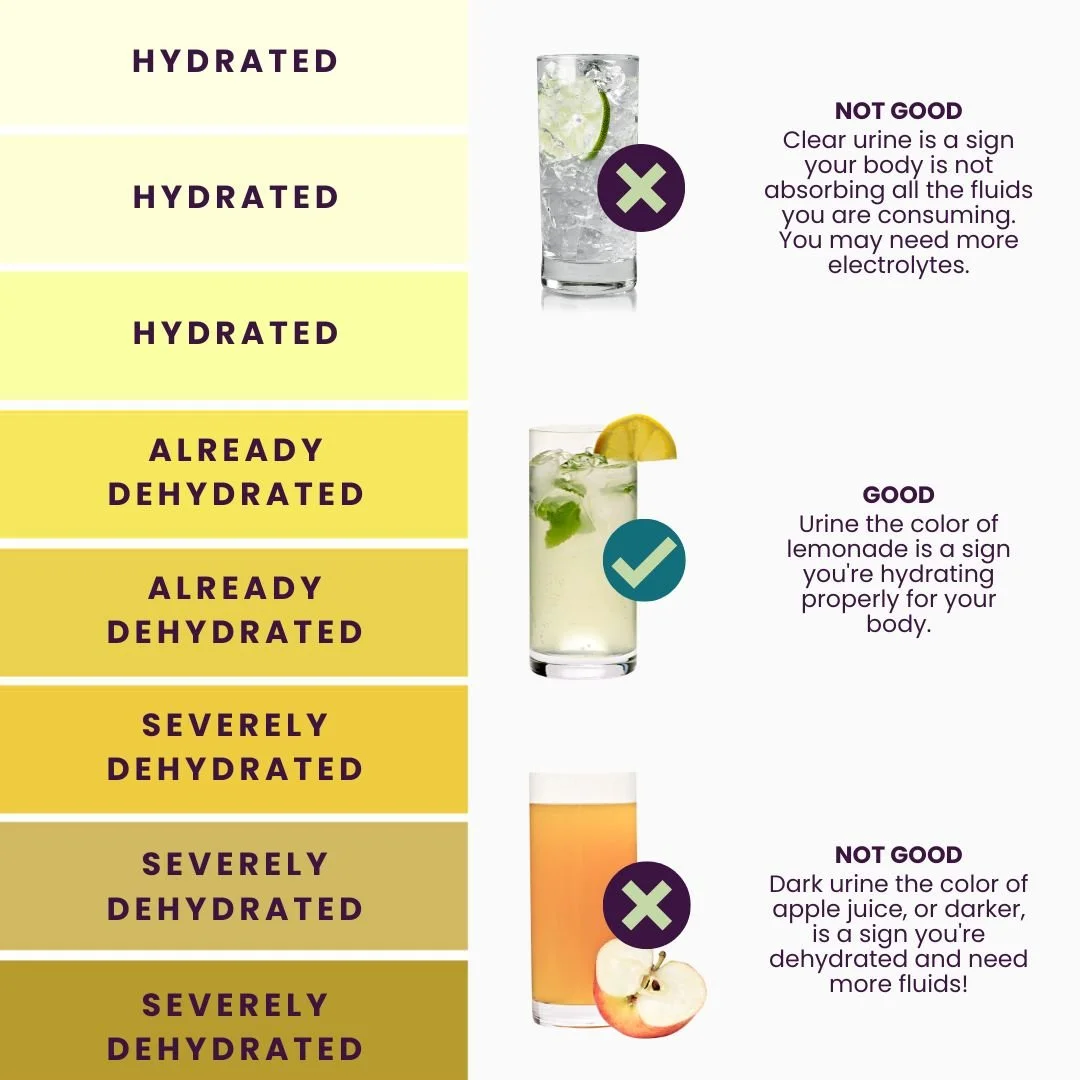Hydration FAQs
You’ve likely heard about the importance of nutrition for athletes, but hydration is just as important as the food you eat– and sometimes overlooked! Water plays several essential roles in the body, including regulating temperature, lubricating joints, aiding digestion, and transporting nutrients. During exercise and competition, we sweat to stay cool, losing both water and sodium in the process. Sodium is one of several key electrolytes that need to be replenished alongside water. Properly fueling your performance and recovery starts with hydration, so let’s get into the nitty gritty details!
WHY IS HYDRATION IMPORTANT?
Adequate hydration is vital for performance, endurance, and recovery. Even mild dehydration can cause fatigue, muscle cramping, dizziness, and decreased coordination. To stay physically and mentally sharp throughout your day and during training, it's important to determine your specific hydration needs. There’s no one-size-fits-all approach when it comes to hydration, and factors like sport type and intensity, sweat rate, environment, and athletic gear can all impact your hydration needs.
WHAT ARE ELECTROLYTES?
Sweat loss that comes along with prolonged physical activity leads to a loss of electrolytes along with water. Electrolytes are essential minerals, including sodium, potassium, magnesium, and calcium, that carry a natural electrical charge. Like water, they play important roles within the body and assist with fluid balance, muscle function, and nerve signaling. Sodium is the major electrolyte lost through sweat, making its replacement essential in athletes.
How TO Calculate Your Sweat Rate
Calculating your sweat rate is a great first step to understanding your unique hydration needs and is relatively simple:
Step 1: Weigh yourself before exercise. Make sure you are completely dry, without clothing and have gone to the bathroom before weighing. Record your pre-exercise weight.
Step 2: Complete your workout and track how much fluid you drink. (Ex: if you use a standard 32 fl oz water bottle and measure 6 oz remaining after your workout, then you know you consumed 26 fl oz.)
Step 3: After exercising, towel off and weigh yourself again without clothing. Record your post-exercise weight.
Step 4: Subtract your post-exercise weight from your pre-exercise weight to determine the amount of water weight lost. Convert lbs to oz (1 lb = 16 fl oz).
Step 5: Plug in your recorded or calculated values into the formula below:
Let’s walk through a real-life scenario now based on the following information:
Pre-exercise weight: 150 lbs
Exercise duration: 2 hour training session (120 min)
Post-exercise weight: 147 lbs
Fluid consumed during exercise: 16 fl oz
No restroom breaks
-
First, we’ll subtract the post-exercise weight (147 lbs) from the pre-exercise weight (150 lbs) to determine that 3 lbs of water weight were lost.
To convert this to fluid ounces, we’ll multiply 3 lbs * 16 fl oz/lb = 48 fl oz.
-
Next, we’ll add the amount of water consumed during training (16 oz) to the 48 oz that were lost to get 64 total fl oz.
-
This individual didn’t go to the restroom, so there’s no need to subtract urine output.
-
Finally, we’ll divide 64 oz by 2 hours to find that the sweat rate is 32 oz fluids lost per hour of training.
Once you have determined your sweat rate, your goal should be to replace 80-100% of that amount during and/or after your workouts.
Are You A Salty Sweater?
Do you notice white, chalky marks on your clothes or skin after training or competition? Does your sweat sting your eyes? Do you experience frequent muscle cramps or crave salty foods after intense exercise?
If you answered YES to these questions, then you may be a salty sweater! Salty sweaters need to prioritize sodium replacement through food and electrolyte-containing beverages during and/or after exercise. If you lose large amounts of sodium through sweat and only rehydrate with water, you may be at risk of developing hyponatremia, or low blood sodium levels. Hyponatremia can cause symptoms such as nausea, confusion, headaches, muscle cramps, and—in severe cases—life-threatening complications. Replenishing sodium helps maintain proper blood sodium and fluid levels, supports nerve and muscle function, and keeps your electrolytes in balance.
Assessing Hydration Status
One of the easiest ways to measure hydration is by assessing the color of your urine. Use a urine color chart like the one below to see where you fall:
Electrolyte Recommendations
Athletes have unique electrolyte needs due to the physical demands of training and competition. As mentioned earlier, factors such as sport type and intensity, sweat rate, environment, and even athletic gear can all influence an individual’s electrolyte requirements. For example, marathon runners, who engage in continuous, steady-state exercise for 2 to 4 hours or more, can experience substantial fluid and electrolyte losses. In contrast, weightlifting involves short, intense bursts of effort with longer recovery periods, resulting in minimal electrolyte loss compared to endurance sports. The marathoner will need to prioritize electrolyte-rich beverages during and after their competition while weightlifters can most likely meet their electrolyte needs through regular meals and fluids (unless they’re training in the heat). Replenishing electrolytes through foods, drinks, or supplements is essential for both performance and recovery. Below are some of our favorite electrolyte options for different activity levels:
The bottom line:
Staying properly hydrated and maintaining electrolyte balance is essential for athletic performance, especially as sweat rates and fluid losses can vary widely between individuals and sports. Understanding your personal hydration needs and choosing the right electrolyte strategy can help prevent fatigue, cramps, and performance decline.
Have more questions or need assistance figuring out your unique needs? Feel free to contact us for an intro call — we’d love to help you out!
References:
Burke L, Deakin V. Clinical Sports Nutrition. 6th ed. Mcgraw-Hill Education (Australia) Pty Ltd; 2021:CH 14: Competition Fluid and Fuel.
Ayotte D Jr, Corcoran MP. Individualized hydration plans improve performance outcomes for collegiate athletes engaging in in-season training. J Int Soc Sports Nutr. 2018 Jun 4;15(1):27. doi: 10.1186/s12970-018-0230-2. PMID: 29866199; PMCID: PMC5987390.




